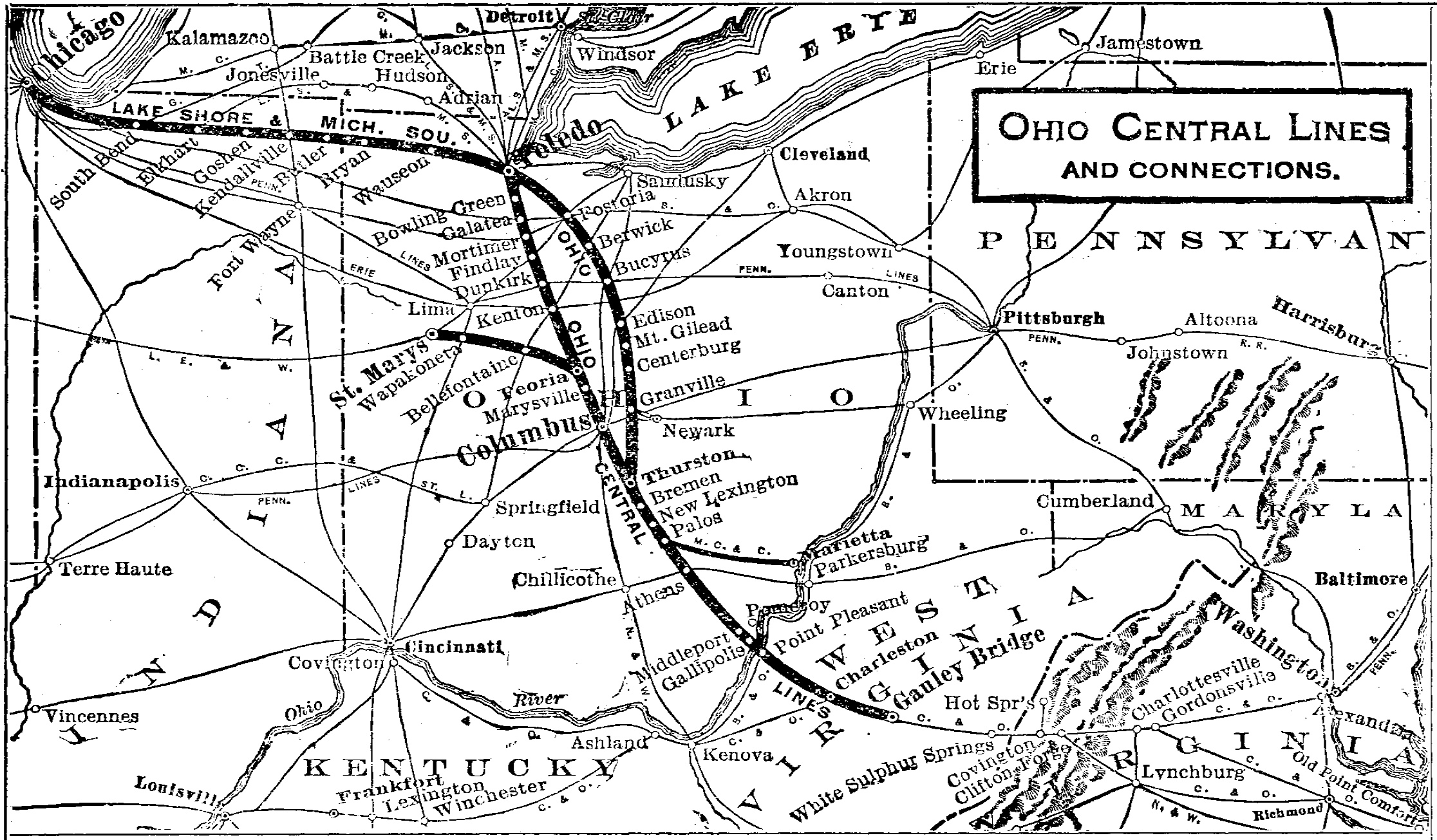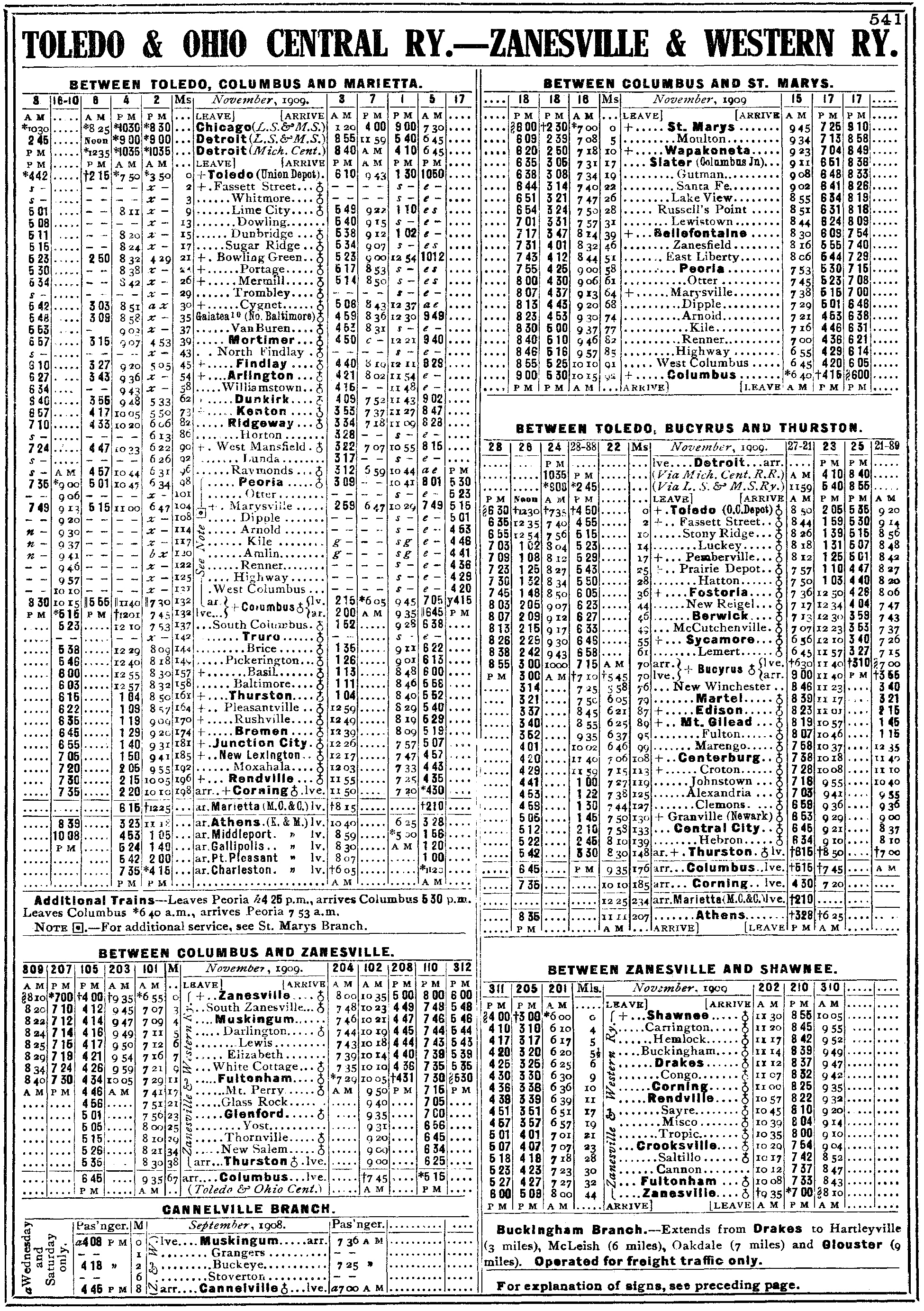Toledo & Ohio Central Railway: Map, History, Timetables
Published: February 15, 2025
By: Adam Burns
The origins of the Toledo & Ohio Central Railway trace back to post-Civil War era, during a time when railroads fever that swept across the United States. Its earliests predecessor was formed to connect the state's central region via a north-to-south routing in an effort to tap southeastern coal mines.
Despite early financial difficulities the system would eventually establish a Lake Erie connection at Toledo with the Ohio River, and also extend into central/southern West Virginia.
Flourishing by 1922, the Toledo & Ohio Central was leased by the large New York Central System in 1928. Ultimately, it was fully integrated into the NYC in 1938.
System Map (1910)
Origins and Early Development
The genesis of the T&OC was the Atlantic & Lake Erie Railroad (A&LE), formed in 1869 to connect Toledo with Pomeroy, Ohio, along the Ohio River, deliberately circumventing Columbus to the east in an effort to tap coal mines in the state's southeastern region.
The A&LE only managed to construct 7 miles of track, extending southeast from New Lexington and terminating at an unfinished tunnel in Moxahala. The railroad underwent a reorganization as the Ohio Central in 1876, yet it had fallen into receivership by 1878.
The foundering operation was subsequently sold to new interests who formed the Columbus & Sunday Creek Valley Railroad and acquired the completed Moxahala-New Lexington segment. In addition, with greater resources available the tunnel was completed and the line extended 57 miles northward to Columbus.
Despite the significant expenses incurred in the tunnel's completion, the future of the line appeared promising, leading to the acquisition of the remainder of the Ohio Central (OC) charter.
Expansion
By 1882, the Toledo to Middleport/Pomeroy line was finished. Subsequently, OC acquired the Atlantic & Northwestern (A&NW) and the Richmond & Allegheny (R&A).
The Atlantic & Northwestern existed largely as a concept, aspiring to cross the Ohio River to Charleston, West Virginia, while the Richmond & Allegheny connected Richmond to Clifton Forge, Virginia.
The newly formed Richmond, Allegheny & Ohio Central aimed to bridge existing gaps to provide access to ports in Richmond and Toledo while servicing the intervening coal fields, ensuring reliable coal transit both eastward and westward.
However, legislative resistance from Virginia blocked the R&A's entry into the state, depriving the line of an essential Eastern seaport, leading to its financial instability and subsequent receivership in 1883.
Despite setbacks, efforts to extend the line to Charleston and its coal fields were fulfilled. By 1885, freight volumes increased, allowing a recovery and rebranding to the Toledo & Ohio Central Railway. In 1892, the T&OC acquired the Toledo, Columbus & Cincinnati, which was building a nearby route running south from Toledo to Columbus via Kenton.
Completion of the segment from Kenton to Columbus occurred in 1893, connecting it to the former Ohio Central branch that had expanded from New Lexington in preceding years. Consequently, the T&OC established two functional routes between the Ohio River and Toledo.
Operations
The T&OC became known as the "Coal Line," which was essential to the economic vitality of towns such as Columbus, Bucyrus, and Athens. The reliable transportation of black diamonds was particularly important for fueling the growing manufacturing operations in Ohio and the broader region.
The early 20th century saw the T&OC thriving as it broadened its reach and influence, supported further by connections with all of the major eastern trunk lines passing through Ohio (New York Central, Pennsylvania, Baltimore & Ohio, and Erie).
Challenges and Ownership Changes
In 1928, the T&OC was leased by the New York Central, one of the giants of American rail travel. This lease marked a turning point and formally integrated T&OC into larger operations, streamlining administrative and operational aspects under NYC's purview. This transition, while providing financial stability, signaled the beginning of a gradual decline in the independence of the T&OC as a standalone entity.
Transformation
Post-World War II era transformations in transportation, including the rise of interstate highways and air travel, led to a decline in rail travel demand. The T&OC experienced diminishing relevance in passenger services, although its freight operations remained critical in some quarters.
The legacy of the T&OC was cemented by its impact on regional development. It facilitated the efficient transport of resources, promoting industrialization and urbanization in Ohio. Moreover, the cities and towns along its tracks saw significant socioeconomic changes influenced by the connectivity provided by the railway.
Under the NYC the line operated as part of its coal feeder into West Virginia where it interchanged with the B&O, Chesapeake & Ohio, and Virginian at or near Charleston.
The so-called West Virginia Secondary later passed into the hands of Penn Central, and then Conrail before its acquisition by Norfolk Southern in the 1999 split by CSX Transportation. Following a downturn in traffic by the 2010s it was leased to Watco and is now operated as the Kanawha River Railroad.
Timetables (1910)
Legacy
The Toledo and Ohio Central Railway stands as a testament to the transformative power of railways in American history. From its ambitious beginnings to becoming part of the colossal network of the NYC, the T&OC played a key role in developing Ohio's economy and laying the foundations of modern transport infrastructure.
Despite its eventual absorption and the decline of its distinctive identity, the railway's legacy is evident in the progress and growth it spurred during the industrial era. The history of the T&OC is a microcosm of the broader narrative of American railroads—marked by innovation, expansion, challenges, and enduring impact.
Recent Articles
-
Christmas Train Rides On Minnesota Streetcars!
Nov 21, 25 09:15 AM
In Minneapolis and the lakeside town of Excelsior, the Minnesota Streetcar Museum keeps alive the history of the region's streetcars, including seasonal Christmas rides! -
Michigan Christmas Train Rides On The Huckleberry!
Nov 21, 25 09:10 AM
If the sound of a steam whistle and the glow of twinkling lights stir something nostalgic in you, there’s a place in mid-Michigan where those simple joys come together every holiday season. -
A Massachusetts Christmas Train Ride By Trolley!
Nov 21, 25 09:08 AM
Tucked into the postcard-perfect village of Shelburne Falls, Massachusetts, the Shelburne Falls Trolley Museum is a small, community-powered treasure that brings local history to life one clanging bel…







